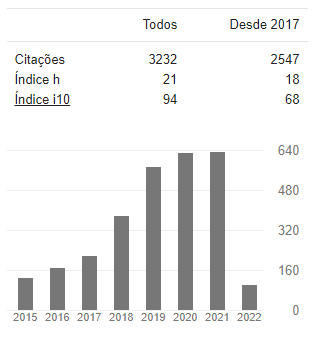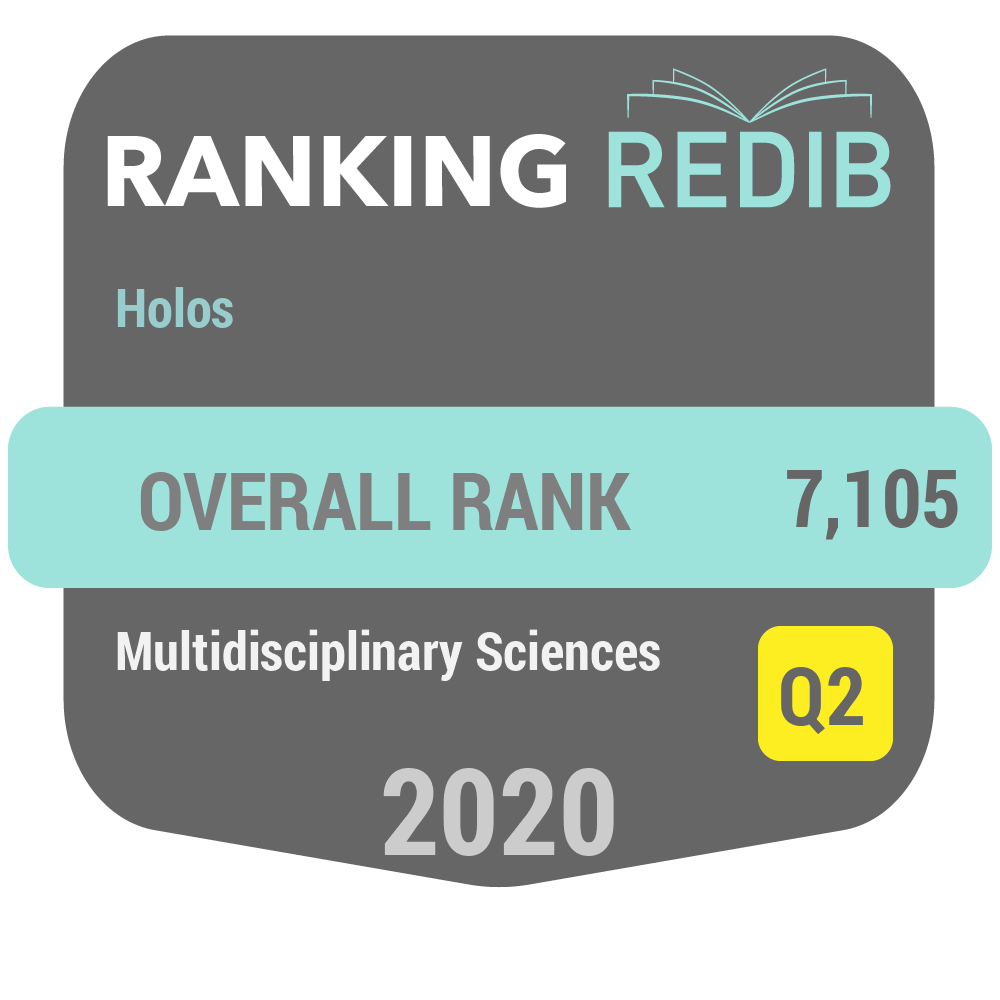ANÁLISE DE COMPONENTES PRINCIPAIS PARA CORRELACIONAR VARIÁVEIS CLIMÁTICAS SOBRE A REGIÃO DO RIO GRANDE DO NORTE
Palavras-chave:
Temperatura do ar, Precipitação, Velocidade do vento, Umidade relativa do ar, Modelo Climático RegionalResumo
Na Geração de energia elétrica, saber como as variáveis climáticas se relacionam é importante para tomada de decisões estratégicas. Esta pesquisa tem como objetivo principal averiguar a relação entre as variáveis climáticas: temperatura do ar, umidade relativa do ar, precipitação e velocidade do vento simuladas a partir de um Modelo Climático Regional para o litoral norte do Rio Grande do Norte durante o passado recente entre 1986 e 2005. Os dados são simulados pelo modelo RegCM4.7 e os resultados obtidos a partir da técnica de Análise de Componentes Principais. A partir dos resultados, obteve-se que a Componente Principal 1 explicou 75,74% da variabilidade dos dados, e observou-se correlação negativa muito forte entre velocidade do vento e precipitação, deste modo, observada complementaridade hidro eólico na região.
Downloads
Referências
Agência Nacional de Energia Elétrica. (2011). Atlas Eólico do Brasil
Amarante, O. A. C. (2001). Atlas do potencial eólico brasileiro. Centro de Pesquisas de Energia Elétrica (CEPEL).
Anthes, R. A., Hsie, E. Y., & Kuo, Y. H. (1987). Description of the Penn State/NCAR mesoscale model version 4 (MM4) (p. 66). Boulder: NCAR.
Brito, B. M. N. (2021). Correlação entre variáveis meteorológicas e focos ativos para o Rio Grande do Norte.
Collins, W. J., Bellouin, N., Doutriaux-Boucher, M., Gedney, N., Hinton, T., Jones, C. D., ... & Halloran, P. (2008). Evaluation of the HadGEM2 model. Hadley Centre Technical Note HCTN 74, Met Office Hadley Centre, Exeter, UK.
Devore, J. L. (2006). Probabilidade e estatística para engenharia e ciência. São Paulo. Thomson Pioneira, 706 p.
Diniz, M. T. M., & Pereira, V. H. C. (2015). Climatologia do estado do Rio Grande do Norte, Brasil: sistemas atmosféricos atuantes e mapeamento de tipos de clima. Boletim Goiano de Geografia, 35(3), 488-506.
Emanuel, K. A. (1991). A scheme for representing cumulus convection in large-scale models. Journal of the atmospheric sciences, 48(21), 2313-2329.
Emanuel, K. A., & Živković-Rothman, M. (1999). Development and evaluation of a convection scheme for use in climate models. Journal of the Atmospheric Sciences, 56(11), 1766-1782.
Giorgi, F., Marinucci, M. R., Bates, G. T., & De Canio, G. (1993). Development of a second-generation regional climate model (RegCM2). Part II: Convective processes and assimilation of lateral boundary conditions. Monthly Weather Review, 121(10), 2814-2832.
Giorgi, F., Jones, C., & Asrar, G. R. (2009). Addressing climate information needs at the regional level: the CORDEX framework. World Meteorological Organization (WMO) Bulletin, 58(3), 175.
Giorgi, F., Coppola, E., Solmon, F., Mariotti, L., Sylla, M. B., Bi, X., ... & Brankovic, C. (2012). RegCM4: model description and preliminary tests over multiple CORDEX domains. Climate Research, 52, 7-29.
Giorgi, F., & Elguindi, N. Model RegCM User’s Guide Version 4.4 Trieste, Italy October 21, 2013.
Hair, J. F., Black, W. C., Babin, B. J., Anderson, R. E., & Tatham, R. L. (2009). Análise multivariada de dados. Bookman editora.
Hongyu, K., Sandanielo, V. L. M., & de Oliveira Junior, G. J. (2016). Análise de componentes principais: resumo teórico, aplicação e interpretação. E&S Engineering and science, 5(1), 83-90.
Hongyu, K. (2018). Análise Fatorial Exploratória: resumo teórico, aplicação e interpretação. E&S Engineering and Science, 7(4), 88-103.
IRENA, T. (2020). Renewable energy statistics 2020.
Jolliffe, I. T. (2002). Principal component analysis for special types of data (pp. 338-372). Springer New York.
Kaiser, H. F. (1958). The varimax criterion for analytic rotation in factor analysis. Psychometrika, 23(3), 187-200.
Kousky, V. E. (1979). Frontal influences on northeast Brazil. Monthly Weather Review, 107(9), 1140-1153.
Lattin, J., Carroll, J. D., & Green, P. E. (2011). Análise de dados multivariados. São Paulo: Cengage Learning, 475.
Matos, D. A. S., & Rodrigues, E. C. (2019). Análise fatorial.
Marengo, J. A., Galdos, M. V., Challinor, A., Cunha, A. P., Marin, F. R., Vianna, M. D. S., ... & Bender, F. (2022). Drought in Northeast Brazil: A review of agricultural and policy adaptation options for food security. Climate Resilience and Sustainability, 1(1), e17.
Moss, R. H., Edmonds, J. A., Hibbard, K. A., Manning, M. R., Rose, S. K., Van Vuuren, D. P., ... & Wilbanks, T. J. (2010). The next generation of scenarios for climate change research and assessment. Nature, 463(7282), 747-756.
Moura, J. D. F. (2022). AUMENTO DA EFICÁCIA NA GERAÇÃO DE ENERGIA ELÉTRICA PROVENIENTE DOS PARQUES EÓLICOS EM DECORRÊNCIA DA CRISE HÍDRICA NO BRASIL. Revista Valore, 7, 111-120.
Nunes, E. (2006). Geografia física do Rio Grande do Norte. Imagem Gráfica.
Pareja-Quispe, D., Franchito, S. H., & Fernandez, J. P. R. (2021). Assessment of the RegCM4 performance in simulating the surface radiation budget and hydrologic balance variables in South America. Earth Systems and Environment, 5(3), 499-518.
Prado, B. Q. D. M., Fernandes, H. R., Araújo, T. G., Laia, G. A., & Biase, N. G. (2016). Avaliação de variáveis climatológicas da cidade de Uberlândia (MG) por meio da análise de componentes principais. Engenharia Sanitária e Ambiental, 21, 407-413.
Reboita, M. S., Krusche, N., Ambrizzi, T., & Rocha, R. P. D. (2012). Entendendo o Tempo e o Clima na América do Sul.
Silva, A. E. F. D., Gomes, D. T., Silveira, C. D. S., & Sakamoto, M. S. (2020). Desempenho das simulações do Projeto Cordex quanto à representação dos padrões de variação da precipitação no Século XX sobre o município de Fortaleza, Ceará. Revista Brasileira de Meteorologia, 35, 387-396.
Teixeira, R. L. P., Silva, R. A. D., Fontenelle, A. L., Santos, Y. C. D., & Pessoa, Z. S. (2021). “Pensando no hoje e no futuro”: iniciativas de mudanças climáticas nas capitais do Nordeste do Brasil. Confins. Revue franco-brésilienne de géographie/Revista franco-brasilera de geografia, (52).
Uvo, C. R. (1989). A Zona de Convergência Intertropical (ZCIT) e sua relação com a precipitação da região norte do Nordeste do Brasil. INPE.
Utida, G., Cruz, F. W., Etourneau, J., Bouloubassi, I., Schefuß, E., Vuille, M., ... & Turcq, B. (2019). Tropical South Atlantic influence on Northeastern Brazil precipitation and ITCZ displacement during the past 2300 years. Scientific Reports, 9(1), 1698.
Xavier, A. C., Scanlon, B. R., King, C. W., & Alves, A. I. (2022). New improved Brazilian daily weather gridded data (1961–2020). International Journal of Climatology
Downloads
Publicado
Como Citar
Edição
Seção
Licença

Este trabalho está licenciado sob uma licença Creative Commons Attribution-NonCommercial-NoDerivatives 4.0 International License.





































